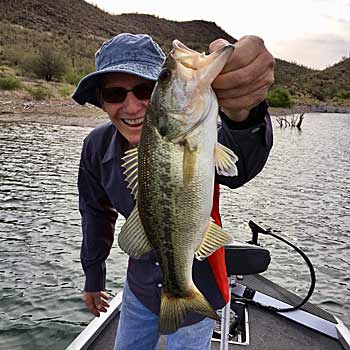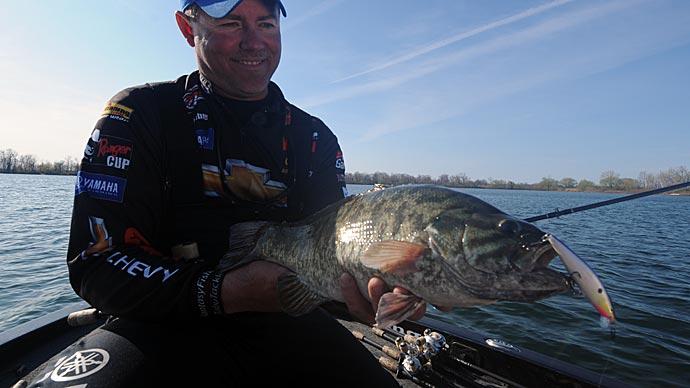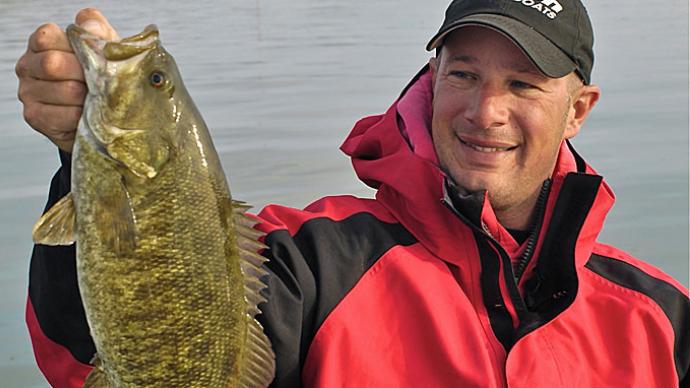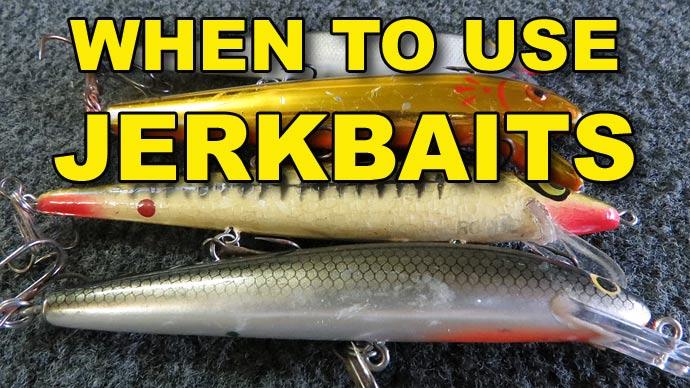
In the 80s, Jimmy Crisp fished the western reservoirs with big sweeps of a long narrow hard bait. He called it “Crispin” and used big spinning gear. Gary Dobyns remembers doing the same when he started fishing tournaments, using heavy fiberglass rods and baitcasting reels. The gear was so heavy that Gary says you had to get into “rippin’ shape,” as the tournament anglers called it, meaning that you had to have real strength and stamina to throw those things all day long. That separated the men from the boys back then; not many guys were serious jerkbait fishermen.
Dobyns was one of the exceptions. He had started throwing little floating Rebels and Rapalas on ponds when he was a kid, and once he got into tournaments, jerk baits were his secret weapon. He won just enough on them to afford to keep fishing, and Clown Rogues were his secret bait back then. He liked the flashiest baits he could find at that time – stuff like chrome and clown. He says he could go down a bank right behind a guy cranking and out-fish him five to one.
Thankfully, the gear and the baits have come a long way these days. Nowadays, Gary fishes jerkbaits on a Dobyns Rod DC704CB with 10-pound-test P-line. He says a fast reel must catch up with your bait on the pause. The line is essential because if you go too heavy, you won’t get the right action, and if you go too light, you’ll get too much stretch.
Classic Jerkin’
Dobyns is a classic jerkbait fisherman, but with nuances. He says that winter and pre-spawn are the absolute perfect time for them. Early in the year, he throws deeper-diving jerkbaits and goes to shallow runners as the water warms up. Gary is a power fisherman, rarely using finesse techniques, and throwing jerkbaits is one of his favorite techniques. It allows him to cover water, find out where the fish are, and catch big fish all year.

The traditional way to fish a jerkbait is to jerk and pause. Gary says it’s the easiest thing out there, and as long as you’re jerking and pausing, you can’t go wrong. When you pause, he says to make sure to put a little slack in your line so the bait goes still. That way, when it starts up again, it looks like a wounded baitfish. When he first started, Gary liked the weather bright and still for jerkbaits, but as time passed, he grew to prefer a little overcast or chop.
Since the fish have gotten wiser, he favors more subtle colors and natural shapes these days. Lucky Craft Pointers have long been a favorite of his. In the early morning (or in low-light conditions), he’ll start with brighter colors like chartreuse shad, clown, etc. He’ll go to subtle colors like ghost minnows or clear baits without much reflection with a bright sky. Darker water also calls for brighter lures, and clear water calls for subtle baits.
Rippin’
What’s the difference between rippin’ and jerkin’? It’s the length of the sweep and usually the bait's size. Rippin’ is a year-round technique but truly shines for a couple of months before spawning. Dobyns chooses which bait to use based on how deep the fish are, or he’ll use one that is the proper depth for the structure or bank he is fishing. He keeps an extensive selection of baits, including shallow-runners and deep divers, tied on and ready on the deck. When Dobyns is ripping, he doesn’t look for fish on the graph – he just flat covers water and aims to pick up all the aggressive fish. He’ll go over the same area several times – sometimes right away, other times, and he’ll re-visit a bank after half an hour or so when the water has warmed up.
Rip baits are fished with a long, mighty sweep to drag them a good way through the water. With the deeper-diving baits, this can be extremely tiring. If you’re throwing a suspending bait, you can rip it down to cover or along riprap, then pause and let it sit for a moment. A bait may rise just a bit while it sits, but that’s a good thing. Often a lure that charges in next to cover and then sits and moves just a little will be the trigger a hidden pre-spawn bass will need. They’re feeding up before the spawn and heading toward the bank.
Dobyns rips points, flats (especially outside flats), walls, walls in river ends of lakes, around any cover, inside coves – just about anywhere. He’ll keep a variety of rip baits tied on for different depths. Once he figures out where they are, he concentrates on those things or areas. So if he’s mostly getting bit on points, he starts running points.
You can do it either down or side when you rip a bait. If you sweep the rod tip down, the bait won’t move as far as it will when you sweep the rod to the side. You use a little heavier line (12#) and a long rod. Sweep, pause, then take up the line as you return the rod to starting position. Keep the line almost taut as you reel up, so you’re ready to hit it if you get bit. Gary almost always changes out the hooks on a new bait unless they come with first-class hooks, and he checks the hooks frequently, replacing any bent or broken hooks. He says if you keep needle-sharp hooks on your rip baits, the fish will hook themselves – crank hard and keep pressure on them. Also, he likes to switch to an oval split ring, so he never has to worry about tying onto the split part of the ring.
Twitching
Smaller, shallow-running jerkbaits can be fished over grass beds, shallow rocky flats, flats covered with stumps, and along the edges of cover even in very shallow water. Mike Baldwin lives near Lake Havasu on the Colorado River, and he says when the water is cold and the fish aren’t doing a lot of chasing, he uses a small jerkbait like a Lucky Craft Pointer 78 or 65 and fishes it on 8-pound-test. He throws it out and fishes it almost like a worm – just shakes it a couple of times then lets it sit. It’s almost like you’re dragging a drop shot – don’t move it too fast. Shad and flash minnow colors are his favorites unless the water is dirty – then he’ll use something with red or chartreuse.

He'll pull the bait over on any brush pile, tree, or log, so it’s just barely moving, sort of like super slow-rolling a spinnerbait. When the lure hits the cover, he stops it, gives it a twitch, and lets it float up a little bit. If the fish are deeper, he’ll use a deeper-running bait and pull it very slowly over a point or channel, with that same stop and twitch movement. He says he tries to get it to bump the cover because the fish won’t go over five or ten feet to chase a bait this time of year – you have to get it right to them.
On Havasu, there are lots of little pockets with sand bars and little to no current. The water warms up first in those pockets – it may be 54 degrees in February. There are often man-made brush piles in these little pockets, and twitching a small jerkbait over these brush piles is a very effective pre-spawn technique. Baldwin says that these little cuts from the Arizona Channel to Blankenship are the first places the bass will spawn, so he starts throwing twitch baits in this area early in the year.
Trolling
You can’t troll in tournaments, but not everyone is a tournament fisherman. When I first started fishing, our first boat was a 12-foot rowboat for which we traded an ATC. It was our pride and joy, painted bright red with a 9 HP Merc on it. We took that tiny boat out to Bartlett Lake at night, and that little Mercury engine was perfect for trolling. With a small chrome and black Rapala minnow tied on and dragged behind the boat, we caught every kind of fish that Bartlett offers – bass, crappie, sunfish, and even the occasional catfish.
Of course, we had no electronics on that boat, so the key to successful trolling was to keep the bait shallow, so it didn’t snag. We’d cruise along the shoreline and wait for the rod to bend. Summer is the best time for night fishing, and once the weather cooled off and we started to fish during the day, we’d switch to deeper diving minnow baits and troll down the center of the coves. Trolling these jerkbaits was so successful that it was a long time before we tried anything else.
When the new dam was built on Lake Pleasant, the lake tripled in size when it finally filled up. The old lake channels were now seriously deep; many of them were lined with trees that hadn’t yet had time to rot away. One guy I know regularly caught fish that were 10+ by trolling big rip baits with downriggers. He let them go using a metal milk crate and a rope. Everybody hated that guy, but I think they were also secretly jealous.
General Jerkbait Tips
Check now and then to make sure the bait is running right. Do it in really clear water or a swimming pool. If it goes off to one side too much, you won’t get any depth out of it. This tuning is an absolute must for ripping – when you rip it, you’re forcing so much water over the front that if it’s not running true, it won’t dive much.
- You’ll catch the biggest bass early in the year – slow and cold.
- Keep an assortment of jerkbaits on the deck to cover all depths as you run the shoreline. Even after you find out where and how deep they are biting, that will usually change, so be prepared to pick up different bait as the day progresses.
- If the jerkbait bite dies and you can’t pick it up again by switching to a deeper or shallower bait, try hanging around and try a jig or a Carolina rig.
- For some reason, fishing at a 45-degree angle to the shore seems to catch more fish.
- When you’re fishing shallow water, turn off your electronics. You don’t need them, and they make noise that the fish can hear.
- If fish are following your bait and not taking it – speed up, don’t slow down.
- In colder water, you should still snap the bait but give it a longer pause. Fish like to take the bait when it stops, especially suspending lures.
- When fishing a point, stay on the point and cast in all different directions. Try sitting up shallow and fan-casting out so the bait runs uphill.
- Make sure to keep your hooks sharp.
BassResource may receive a portion of revenues if you make a purchase using a link above.




